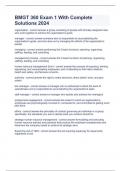Samenvatting
Summary - Introduction to Organization Studies
- Instelling
- Tilburg University (UVT)
Summary of the book for the course Introduction to Organization Studies in the first year of Global Management of Social Issues. With this summary, I got an 8,4 on the exam.
[Meer zien]














